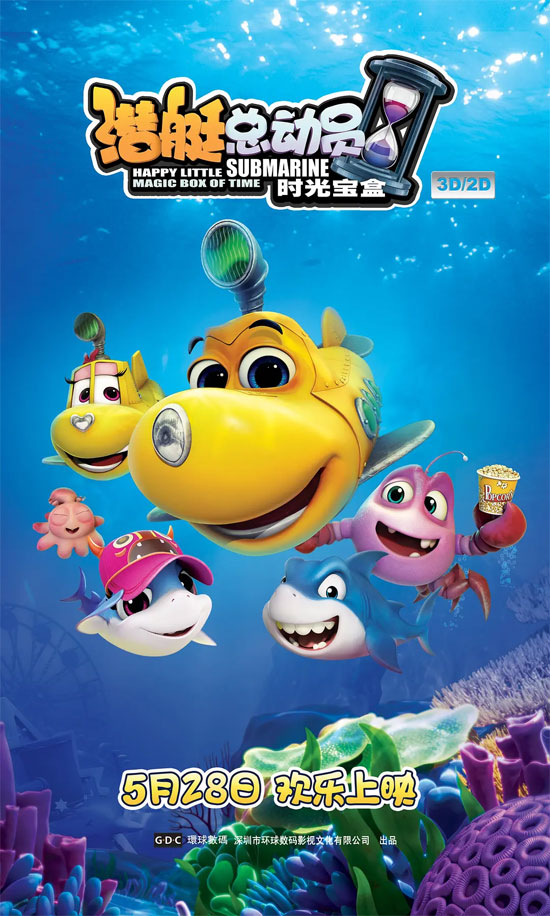Film Name: 潜艇总动员5:时光宝盒 / Happy Little Submarine Magic Box of Time

The Submarine Rally brand has reached this point in China with a growing disinterest in its two submarine characters. After all, they’re imported from overseas—no matter how well-made, they’ll never be the brand’s own flesh and blood. Thus, it’s only natural that each film’s focus inevitably shifts to the supporting characters surrounding the submarines. Thus, we needn’t dwell on how many minutes the submarines appear or their importance within the films. Treating them as optional elements suffices.
The crux lies in how deeply the films explore the concept of the “Time Capsule.”
Perhaps it stems from the profound impression left by the third installment of the “Qian Ting Zong Dong Yuan” series—Rainbow Treasure. I often find myself comparing the quality of subsequent installments to that 2013 film, only to be left feeling disappointed. While Treasure of the Rainbow featured tangible treasures, its true treasure lay in the genuine friendship and deep bonds gradually formed between the little submarine and its companions. The film truly succeeded in making the journey of seeking treasure more meaningful than the treasure itself. But what about the Time Capsule? How much of the film’s plot, how much ink, how much focus was dedicated to the theme of time, allowing us to feel the joy, sorrow, and immense dramatic tension that time brings?
We cannot reduce the Time Capsule to a mere toy-like prop, a mere object of contention among characters. We cannot limit its function to simplistic gimmicks—making the old young, or the young mature—reducing time travel to shallow entertainment. We certainly cannot design the method to nullify the Time Capsule’s effects as something as uninspired and devoid of metaphor as melting it with a volcano, turning a journey through time into a make-believe game that can be ended at any moment.
Jack and the Beanstalk captivates us because each of us harbors a desire to glimpse the giant’s castle in the sky and seize that golden-egg-laying hen to strike it rich. When the beanstalk’s towering vine collapses, it mirrors the shattering of our own ambitions, pulling us back to reality. In fairy tales, every prop should tug at the heartstrings like this. So where is the mystery and fatalism of the Time Capsule? Where are the desires it ignites in different characters and their subsequent shattering? And where are the positive forces—like family bonds and friendships—forged through the fulfillment and collapse of these very desires?
Would a bunch of troublemakers really go to such lengths to obtain and keep the Time Capsule just because they wanted to ride a roller coaster? That motivation seems rather flimsy and insufficient. The true motivation tied to time might be that they wanted to become adults—respected adults no longer subject to discipline—and thus sought to grow up using the Time Capsule. Of course, they might eventually discover that this “growing up” isn’t as wonderful as they imagined.
What exactly is the one-eyed shark’s attitude toward shrinking—excitement or shame? It loses the power and charisma of the king of the deep, yet gains a brief respite from its paternal duties. Throughout its journey, it plays and frolics without any urgency to revert, despite the film’s insistence that it will keep shrinking unless the time capsule is destroyed. Frankly, it feels like the audience is more anxious about this than the shark itself. Admittedly, the film’s conclusion highlights the father-daughter bond, with the baby shark voicing sentiments that resonate deeply with parents watching with their children. Yet this familial connection lacks sufficient grounding. The film fails to adequately address the relationship between the shrunken One-Eye fulfilling his childhood dream of becoming an explorer and his fulfillment of paternal responsibilities.
The “treasure” of the Time Capsule, much like the “treasure” of the Rainbow Treasure, is something worthy of deep exploration. This doesn’t mean the film needs to be obscure or profound, but rather that it should genuinely convey the creators’ thoughtful consideration. Unfortunately, it falls short. In my view, the Time Capsule should at least embody these treasures: First, the time experienced is a treasure, fostering maturity and responsibility—this resonates best with the one-eyed shark. Second, the time lost is a treasure; skipping directly from childhood to adulthood may grant a fearsome exterior but not a mature heart. Life must be lived step by step—this truth suits the mischievous trio. Third, childhood itself is a treasure, filled with parents’ selfless love that nurtures our growth. Though we may struggle to understand how that love is expressed, it ultimately touches our hearts—this resonates most with the little shark, Mei Sha.
Only when you fully grasp the essence of these “treasures” within the time capsule will you realize that the nonsensical arguments and roughhousing in the amusement park scenes are actually plotlines entirely disconnected from the main narrative. Only then will you notice how jarringly awkward and comical Tudou’s product placements truly are. you’ll feel how the borrowed references to Iron Man, Captain America, and the Star Wars heroes, though creative, lack any groundwork and feel jarringly out of place; you’ll understand why the lack of proper development in the interactions between One-Eyed Shark and Meisha leaves audiences disappointed—this is what viewers truly wanted to see; and you’ll realize that the only thing that can truly unlock the bonds of time is familial love itself, not some volcanic lava.
It remains a superficial romp through time travel, ultimately tacking on a token elevation of familial bonds. The Time Box could have been so much more.
Please specify:Anime Phone Cases » Happy Little Submarine Magic Box of Time 2015 Animation Film Review: Where is the treasure of time?